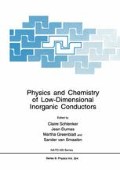Abstract
The standard description of (three-dimensional) metals is based on the Landau theory of Fermi systems (Fermi Liquid theory) [1]. Within this theory all low-energy and low- temperature properties are described in terms of independent elementary excitations (quasi- particles) which behave more or less as free particles. This picture breaks down in one dimensional systems, which are instead described by the so called Luttinger Liquid theory [2]. Indeed experimental evidence suggests that Fermi Liquid theory could break down in a variety of physical situations.
Access this chapter
Tax calculation will be finalised at checkout
Purchases are for personal use only
Preview
Unable to display preview. Download preview PDF.
References
See for instance: P. Nozières, “Theory of interacting Fermi Systems” (Benjamin, 1964);
G.Baym and C. Pethick in “The physics of liquid and solid Helium”, ed. Bennemann and Ketterson (Wiley, 1978)
For a review on and quasi — electronic systems, see J. Solyom, Adv. Phys. 28, 201 (1979).
C. Castellani, C. Di Castro and W. Metzner, Phys. Rev. Lett. 72, 316 (1994).
All energies are measured with respect to the Fermi energy.
S. Tomonaga, Prog.Theor. Phys. 5, 544 (1950);
J. M. Luttinger, J. Math. Phys. 4, 1154 (1963);
D.C. Mattis and E.H. Lieb, J.Math. Phys. 6, 304 (1965).
A. Luther and I. Peschel, Phys. Rev. B 9, 2911 (1974).
D.C. Mattis, J.Math. Phys. 15, 609 (1974)
F.D.M. Haldane, J. Phys. C 14, 2585 (1981).
I. E. Dzyaloshinskii and A.I. Larkin, Sov. Phys. JETP 38, 202 (1974).
H.U. Everts and H. Schulz, Sol. State Comm. 15, 1413 (1974).
F.D.M. Haldane, Phys. Rev. Lett. 45, 1358 (1980)
C. Bourbonnais in “Highly correlated fermion systems and high Tc superconductors” ed. B. Douçot and R.Rammal (Elsevier, 1991)
H.J.Schulz, “The metal-insulator transition in one dimension”, in “Strongly correlated electronic materials: the Los Alamos Symposium 1993”, ed. K.S. Bedell et al. (Addison-Wesley, 1994)
R. Shankar, Rev.Mod.Phys. 66, 129 (1994)
A detailed discussion of the role of conservation laws in deriving these equations is given by W. Metzner and C.Di Castro, Phys Rev. B 47, 16107 (1993)
Notice that eq.(14) has the suggestive form of a gauge transformation: because of eq.(13), the interactions have been gauged out apart from anomalies leading to the RPA “gauge field”.
H.J. Schulz, Int.J. Mod.Phys. B 5, 57 (1991);
C.Bourbonnais and L.G.Caron, ibidem B 5, 1033 (1991);
C.Castellani, C.Di Castro and W.Metzner, Phys.Rev.Lett. 69, 1703 (1992);
M.Fabrizio, A.Parola and E.Tosatti, Phys.Rev. B 46, 3159 (1992);
M.Fabrizio, ibidem B 48, 15838 (1993).
B.Dardel, D.Malterre, M.Grioni, P.Weibel and Y.Baer, Phys. Rev. Lett. 67, 3144 (1991);
B.Dardel, D.Malterre, M.Grioni, P.Weibel, Y.Baer, J.Voit and D.Jérôme, Europhys.Lett. 24, 687 (1993);
M.Nakamura, A.Sekiyama, H.Namatame, A.Fujimori, H.Yoshihara, T.Ohtani, A.Misu and M.Takano, Phys.Rev.B 49, 16191 (1994)
Note that the perturbation theory in 1<d<2 shows indeed the asymptotic dominance of the forward scattering we are considering [3].
P.W. Anderson, Phys Rev. Lett. 64, 1839 (1990).
C.Castellani, C. Di Castro and A.Maccarone, unpublished.
The same result was obtained by P. Bares and X.G.Wen, Phys. Rev. B 48, 8636 (1993);
see also A.Houghton, H.-J Kwon, J.B. Marston and R. Shankar, J. Phys. Condens. Matter (UK) 6, 4909 (1994)
A.Houghton and J.B.Marston, Phys. Rev. B 48, 7790 (1993)
A.Houghton, H.-J. Kwon and J.B. Marston, Phys. Rev. Lett. 73, 284 (1994)
This problem has been extensively analyzed by B.L.Altshuler, L.B.Ioffe and A.J.Millis, Phys.Rev. B 50, 14048(1994).
G. Benfatto and G. Gallavotti, J. Stat. Phys. 59, 541 (1990).
Author information
Authors and Affiliations
Editor information
Editors and Affiliations
Rights and permissions
Copyright information
© 1996 Plenum Press, New York
About this chapter
Cite this chapter
Castellani, C., Di Castro, C. (1996). Fermi and Luttinger Liquids in Low-Dimensional Metals. In: Schlenker, C., Dumas, J., Greenblatt, M., van Smaalen, S. (eds) Physics and Chemistry of Low-Dimensional Inorganic Conductors. NATO ASI Series, vol 354. Springer, Boston, MA. https://doi.org/10.1007/978-1-4613-1149-2_20
Download citation
DOI: https://doi.org/10.1007/978-1-4613-1149-2_20
Publisher Name: Springer, Boston, MA
Print ISBN: 978-1-4612-8449-9
Online ISBN: 978-1-4613-1149-2
eBook Packages: Springer Book Archive

